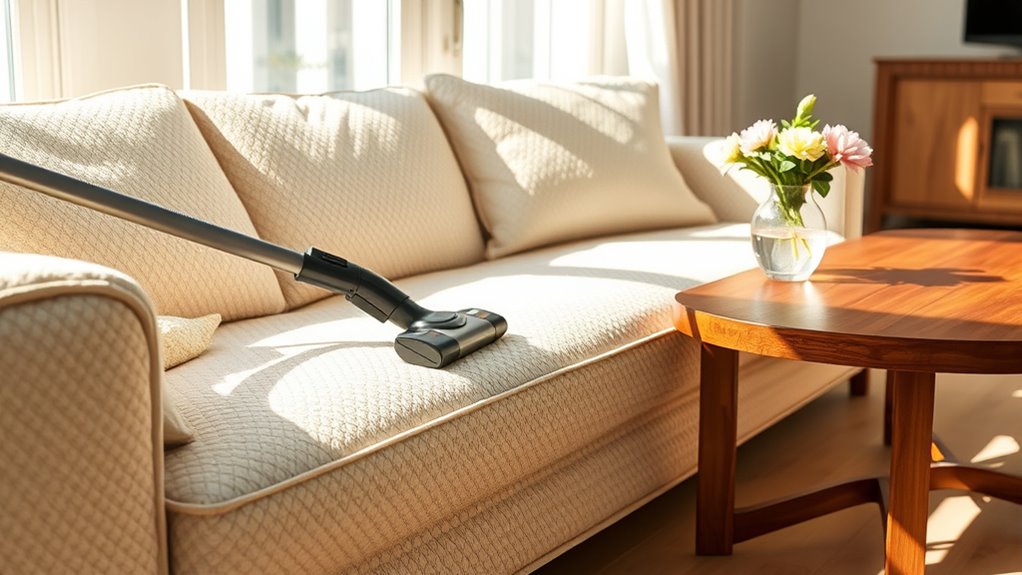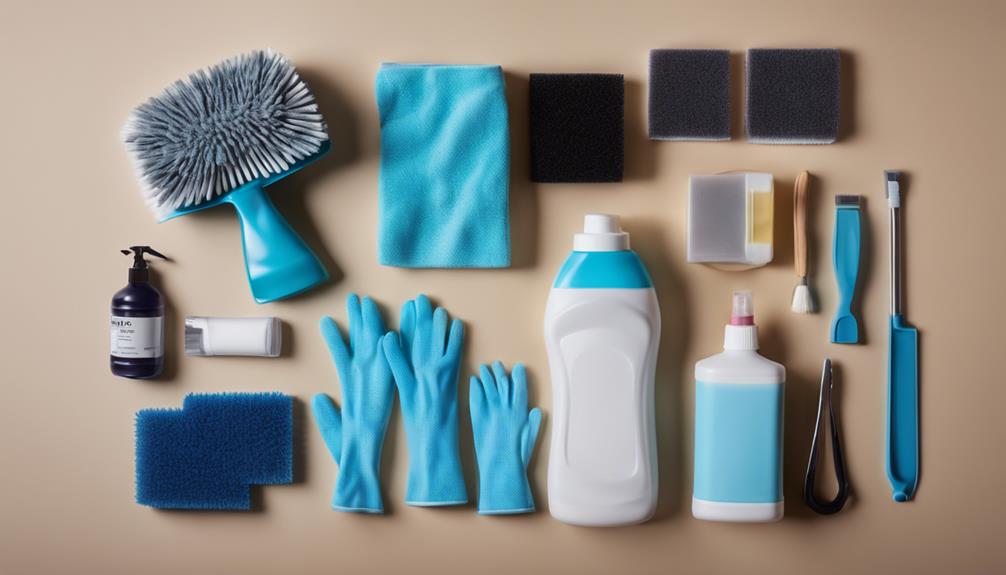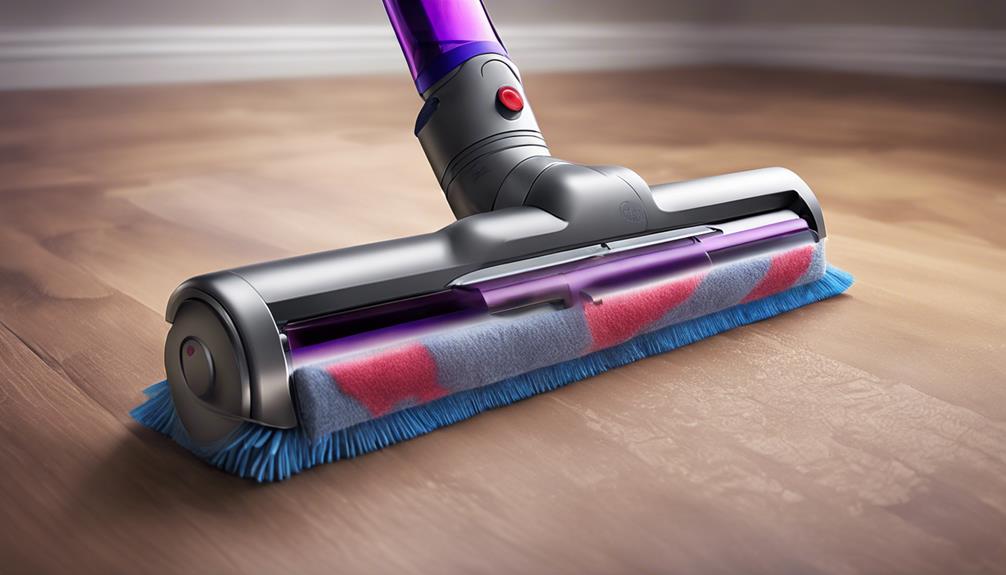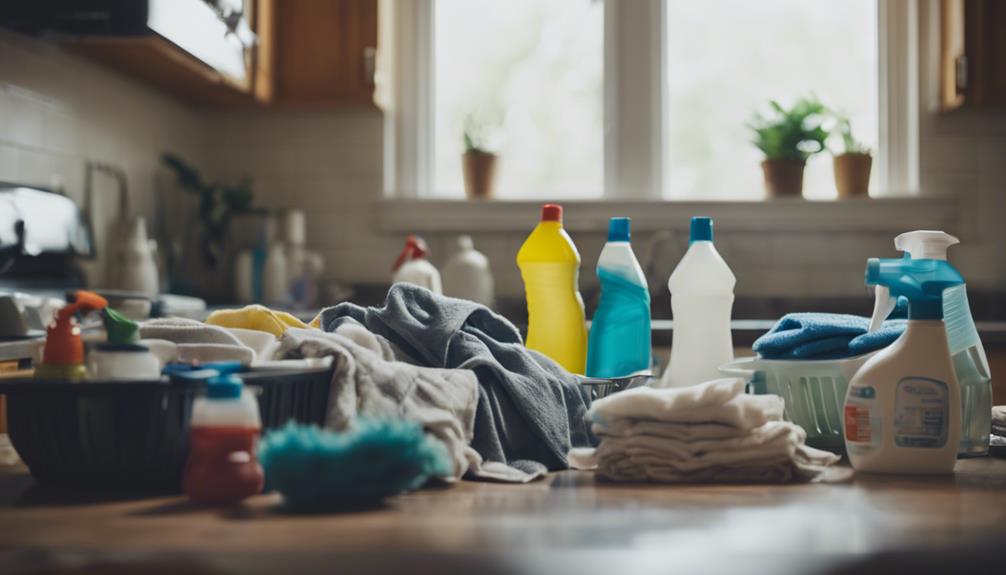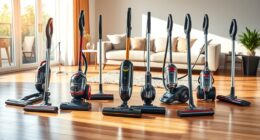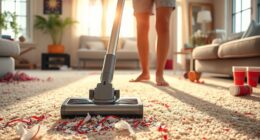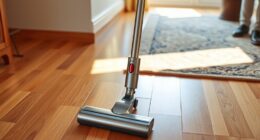Vacuuming your upholstery and furniture regularly is key to keeping them looking new. It removes dust, allergens, and embedded dirt while extending their lifespan. Use the right vacuum attachments and inspect for loose threads before you start. Maintain your vacuum cleaner for peak performance, adjusting the settings based on fabric type. Don’t forget to create a consistent cleaning schedule for high-traffic areas. There’s even more to learn about enhancing your home’s appearance and health.
Key Takeaways
- Vacuum upholstery weekly to remove dust, dirt, and allergens, improving air quality and extending furniture lifespan.
- Use upholstery attachments and soft brushes to clean delicate fabrics without causing damage.
- Inspect upholstery for loose threads or pilling before vacuuming to prevent further damage.
- Establish a regular vacuuming schedule, adjusting frequency based on traffic and presence of pets or children.
- Consider professional cleaning every 1-2 years to revitalize furniture and reduce allergens effectively.
Importance of Regular Vacuuming
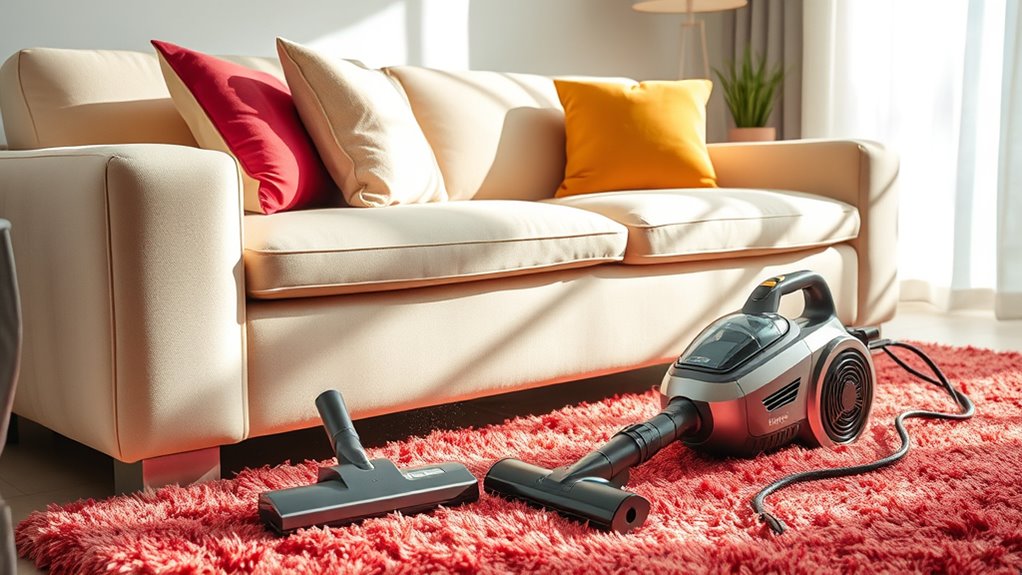
While it might be easy to overlook, regular vacuuming of your upholstery is vital for maintaining a healthy living environment.
By vacuuming at least once a week, you can effectively remove dust, dirt, and allergens that affect indoor air quality and may lead to respiratory issues. Additionally, using a vacuum with high suction power ensures that even the smallest particles are captured effectively. Regular vacuuming with a vacuum featuring a HEPA filter significantly improves the removal of allergens from your upholstery. This routine cleaning not only enhances your home’s atmosphere but also extends the lifespan of your furniture, creating a more organized environment that reduces stress. Investing in top-rated vacuums ensures that you have a reliable tool for this task.
Removing particles prevents wear and tear, keeping your upholstery looking fresh and vibrant.
A systematic approach, like vacuuming from top to bottom, guarantees thorough cleaning and reduces dirt resettling.
Don’t forget to use the right vacuum attachments for delicate fabrics, as this boosts cleaning effectiveness while protecting your upholstery’s appearance. Additionally, regular vacuuming helps to minimize pest infestations, ensuring that your home remains a clean and comfortable space.
Inspecting for Loose Threads and Snags
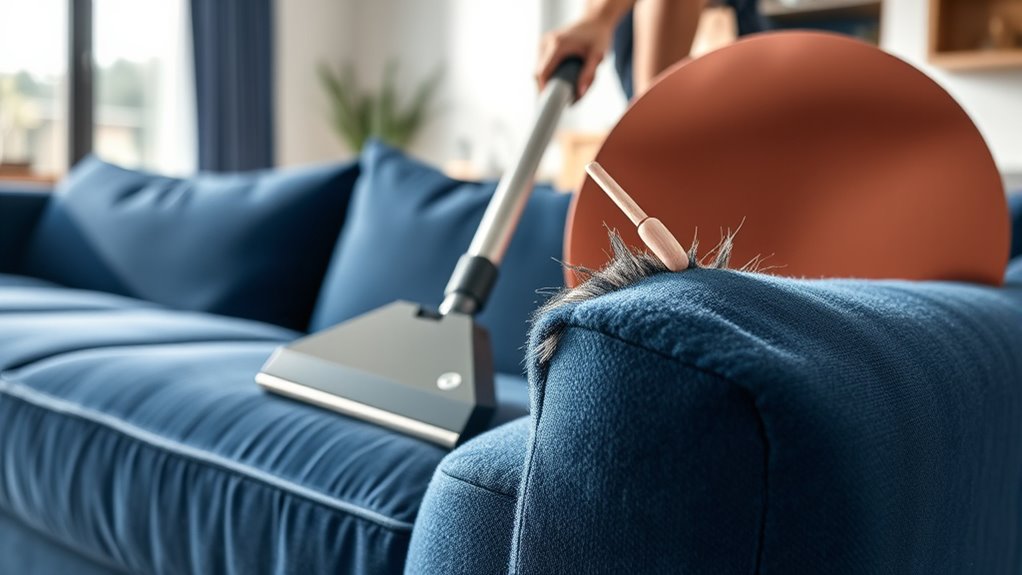
After you’ve established a regular vacuuming routine, it’s important to inspect your upholstery for loose threads and snags.
These issues can worsen under suction, leading to further damage. By addressing them early, you maintain the integrity of your furniture. Additionally, regularly checking for oxidative stress can help ensure that your upholstery remains in good condition by preventing long-term damage from environmental factors. Using the right paint sprayer accessories can also help in maintaining upholstered furniture by allowing you to paint and refresh any wooden parts safely. A thorough inspection can also reveal areas where wear and tear may compromise the fabric’s longevity.
Here’s how to effectively inspect for damage:
- Check for loose threads: Pulling on them can worsen the snag.
- Look for pilling: This signifies wear that may need repairs.
- Examine seams: Confirm they’re intact and secure.
- Avoid vacuuming damaged areas: This prevents irreversible harm during cleaning.
Taking the time to inspect your upholstery helps you catch potential problems before they escalate, keeping your furniture looking new for longer. Additionally, consider how wood stove decor can complement your furniture and enhance your living space’s overall ambiance. Regular inspections also provide insight into your cookie preferences and how they might affect your cleaning routine and overall home maintenance.
Choosing the Right Vacuum Attachments
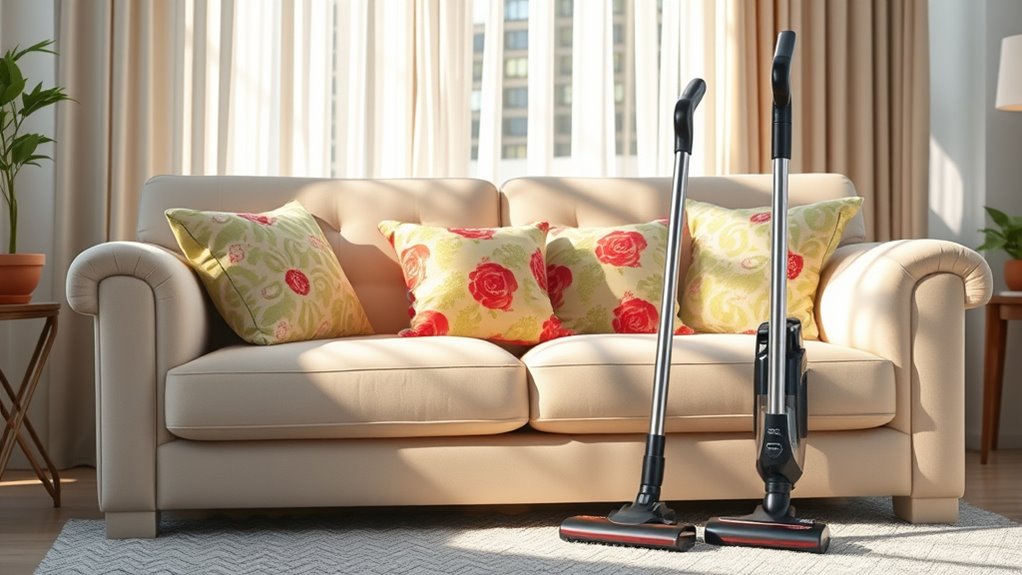
Choosing the right vacuum attachments can make a significant difference in effectively cleaning your upholstery.
Always use the upholstery attachment that comes with your vacuum, as it’s designed specifically for delicate fabrics. A soft brush attachment can lift dust and debris while minimizing the risk of snagging. Additionally, using attachments designed for high refresh rates can help you maintain the quality of your upholstery over time by ensuring thorough cleaning. The use of a vacuum with advanced filtration systems can also enhance your cleaning results by capturing allergens effectively. Using a vacuum with strong suction power is essential for thorough cleaning, as it helps remove dirt and debris effectively. Regular maintenance of your vacuum, including preventive maintenance, can ensure optimal performance while cleaning.
If you’ve got pets, opt for a motorized brush tool to tackle embedded dirt and pet hair efficiently.
Before you start, verify your attachments are clean and free from dust build-up to avoid transferring dirt back onto your furniture.
Finally, always test any new attachment on a small, inconspicuous area first to check for compatibility and to avoid damage.
Additionally, consider using a vacuum that features anti-allergen technology to help reduce allergens in your home while cleaning your upholstery.
Proper attachment choices lead to cleaner, more beautiful upholstery.
Maintaining a Clean Vacuum Cleaner

To keep your vacuum cleaner in top shape, it’s essential to maintain it regularly. Proper maintenance not only enhances performance but also extends its lifespan.
Follow these steps to guarantee your vacuum remains efficient and clean:
- Empty the bag or canister when it’s no more than half full to maintain peak suction.
- Clean or replace the filters as per the manufacturer’s recommendations to guarantee maximum airflow and prevent clogs. Regular filter maintenance is crucial for optimal air purification performance. Ensure that you clean filters every 1-3 months depending on usage. Additionally, using a vacuum with HEPA filters can significantly improve indoor air quality by capturing allergens and dust. Maintaining a clean vacuum is as important as hydration essential for skin health to ensure a healthy living environment. Remember that regular maintenance can also prevent unusual noises that indicate potential issues.
- Inspect and clean the brush attachments for any hair and debris buildup before each use to avoid damage to upholstery.
- Wipe down the exterior with a damp cloth to remove dust and dirt, keeping it hygienic and appealing.
Regularly following these steps will keep your vacuum performing at its best.
Effective Vacuuming Patterns
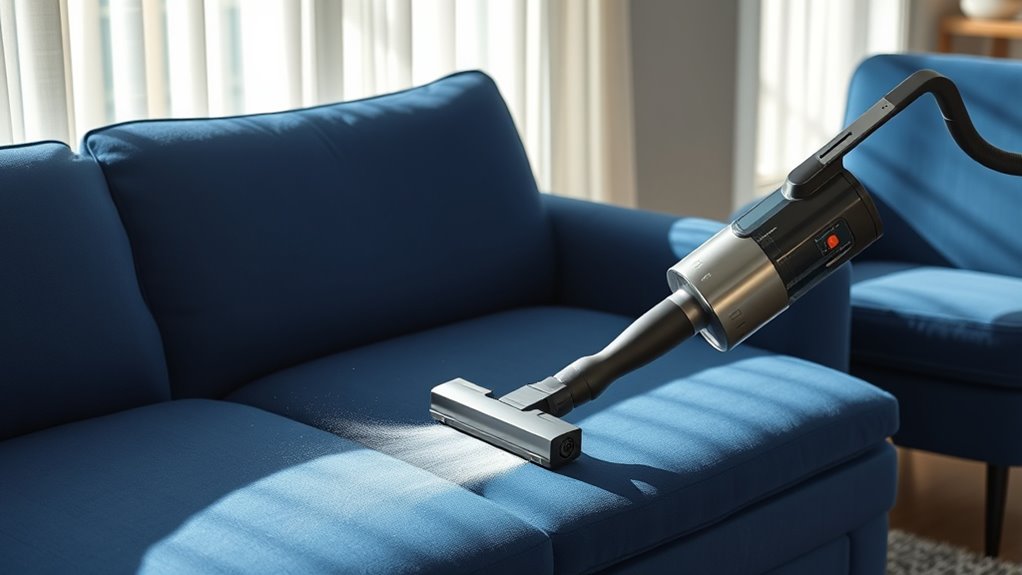
Effective vacuuming patterns are essential for ensuring your upholstery stays clean and well-maintained. Start from the top of your furniture and work downwards, using a systematic approach. Move from the high back to the arms, then to the cushions, and finally the base for thorough coverage without missing spots. Always vacuum across the fabric’s weave direction to optimize dirt removal while protecting delicate fibers. Maintaining a steady movement of the vacuum attachment to prevent fabric damage, especially with a beater brush, is crucial. Additionally, incorporating best cleaning practices can enhance the overall appeal of your home. Regularly using this structured method can extend the life of your upholstery by preventing dirt buildup. Additionally, remember that regularly trimming your cat’s nails can help minimize the risk of damage from scratching while maintaining your furniture’s appearance.
| Step | Area to Vacuum | Movement Direction |
|---|---|---|
| 1 | High Back | Downward |
| 2 | Arms | Downward |
| 3 | Cushions/Base | Across the weave |
Adjusting Suction Settings for Upholstery
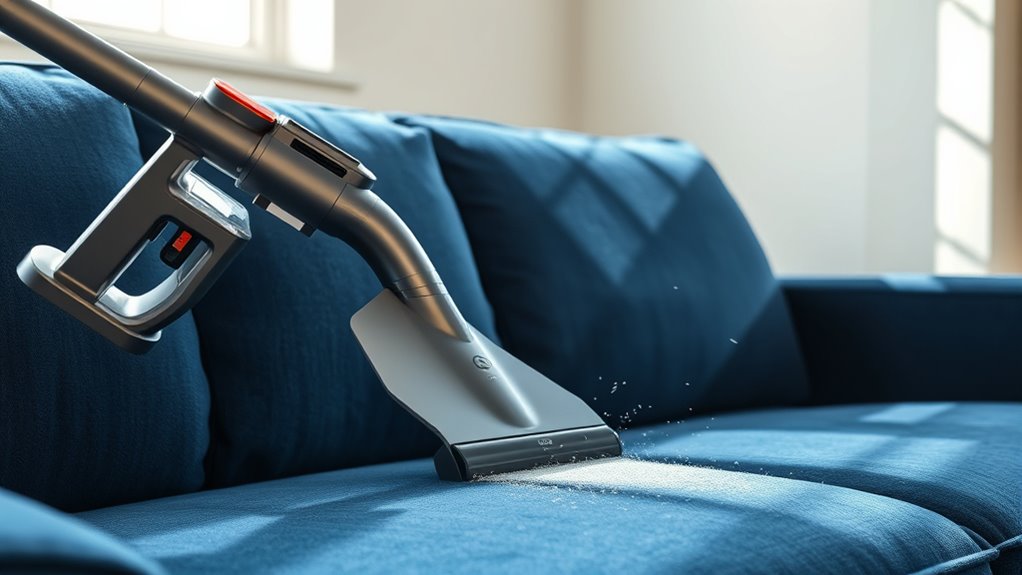
When you’re vacuuming upholstery, starting with the lowest suction setting is key to protecting delicate fabrics.
Always test the suction on a hidden area before you begin, ensuring you don’t damage the material.
Adjust your settings based on the fabric type to keep your furniture looking great while getting the job done.
Importance of Low Suction
While you might think stronger suction means a better clean, using a low suction setting is actually crucial for preserving the integrity of your upholstery. High suction can cause wear and tear, especially on delicate fabrics, leading to fraying or pilling.
Instead, consider these points:
- Low suction helps prevent damage to fragile upholstery fibers.
- Most upholstery materials can effectively remove embedded dirt with gentler settings.
- Starting with low suction guarantees a thorough clean without stressing the fabric.
- Regular use of low suction extends the life of your furniture by minimizing risks while removing debris.
Testing Settings on Fabrics
Before diving into vacuuming your upholstery, it’s essential to test the suction settings on your fabric to verify you’re using the right amount of power.
Start with a low suction setting, especially for delicate fabric fibers, to avoid damage. Always test in an inconspicuous area first before tackling the whole piece.
Adjust suction settings based on the fabric type; thicker materials can handle a bit more power. Confirm your vacuum’s efficiency by checking that the bag or canister isn’t more than half full, as a full bag can hinder cleaning effectiveness.
When vacuuming, always vacuum in the direction of the fabric’s weave, which helps lift dirt without pulling or damaging the fibers.
Protecting Delicate Upholstery Materials
To protect delicate upholstery materials, it’s crucial to start with the lowest suction setting on your vacuum. This approach guarantees gentle cleaning while maintaining fabric integrity. High suction can cause fraying or pilling, especially on fabrics like silk and velvet.
Here are some tips for effective vacuuming:
- Adjust the Suction: Begin with low suction to avoid damage.
- Test Vacuum: Always try the suction on an inconspicuous area first.
- Monitor the Fabric: Check for any signs of distress during cleaning.
- Increase Gradually: If needed, slowly raise the suction while guaranteeing safe dirt removal.
Testing Vacuuming Techniques on Hidden Areas
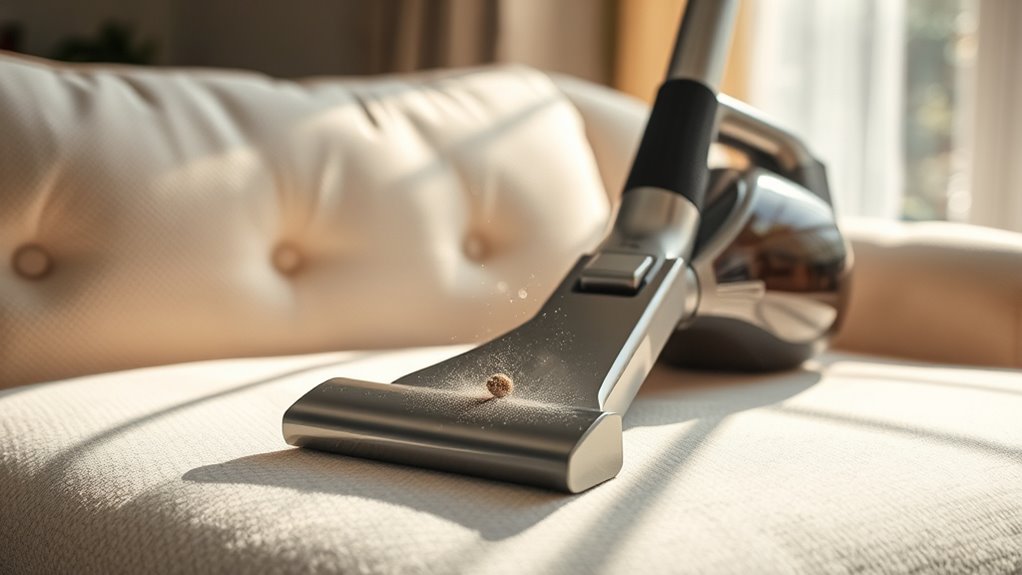
Before you start vacuuming your upholstery, it’s essential to test your techniques on a hidden area.
Ascertain to vacuum in the direction of the fabric’s weave to spot any potential issues. This approach helps you identify the safest suction settings and guarantees your furniture stays in great shape.
Importance of Testing
When testing vacuuming techniques on hidden areas of upholstery, you can safeguard your fabric’s integrity and avoid potential damage. This step is essential, especially for delicate fabrics, guaranteeing you maintain their appearance and prolong their lifespan.
Here are key points to contemplate:
- Assess Suction Strength: Test how the vacuum interacts with your upholstery before using it on visible areas.
- Check Attachment Effectiveness: Confirm the attachments work well without harming the fabric.
- Observe Fabric Response: Notice how the material reacts to different vacuuming techniques.
- Prevent Irreversible Damage: Avoid issues like pilling or fraying by conducting tests first.
Regular testing can help you find the best cleaning methods while keeping your upholstery looking new.
Direction of Fabric Weave
Understanding the direction of your fabric’s weave is essential for effective vacuuming. When vacuuming upholstery, always start in a hidden area to test how the fabric responds. This helps guarantee no visible damage occurs.
Vacuuming in the direction of the fabric weave provides the best cleaning results and minimizes fiber damage. Different fabrics have unique weaves, so identifying yours can guide your suction settings and upholstery attachment choices for ideal care.
Regularly testing these techniques in concealed spots allows you to maintain the overall appearance and longevity of your upholstery. By doing this, you prevent wear while ensuring your furniture stays looking new for years to come.
Tools for Removing Stubborn Pet Hair

Removing stubborn pet hair from upholstery requires the right tools to make the job easier and more effective.
Here are some essential cleaning tools you should consider:
- Handheld Vacuum: A specialized device like the Bissell Pet Hair Eraser is designed for effective removal of embedded pet hair.
- Motorized Brush Attachments: These attachments agitate fabric fibers, dislodging trapped hair for thorough cleaning.
- Rubber Gloves: Rubbing these gloves over upholstery creates static electricity, attracting stubborn pet hair to the surface.
- Lint Rollers: Quick and portable, lint rollers efficiently pick up pet hair from various upholstery surfaces.
Establishing a Vacuuming Schedule
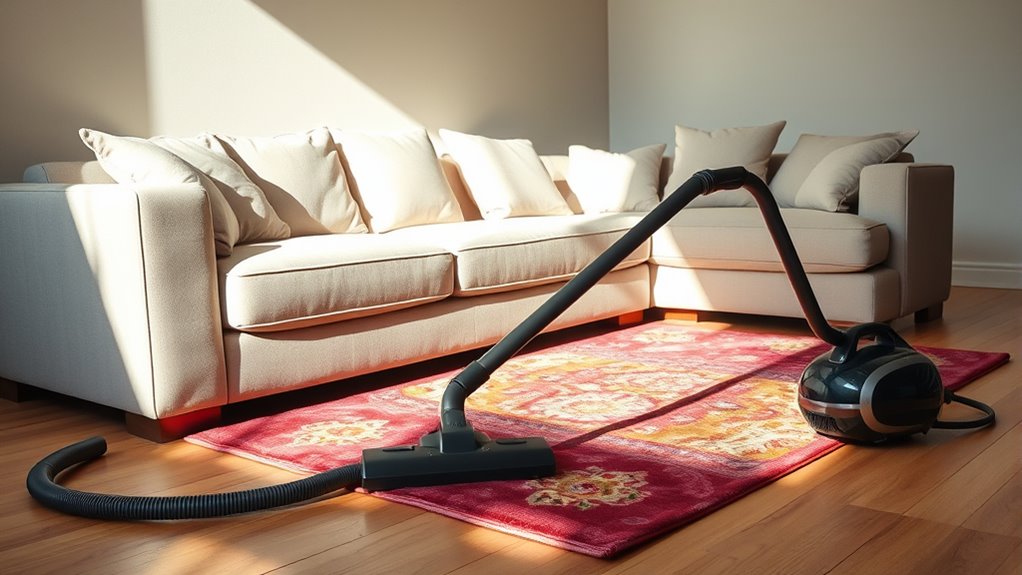
To keep your upholstery looking its best, establishing a vacuuming schedule is essential. Aim to vacuum your upholstered furniture at least once a week to prevent dust and maintain its appearance.
If you have high-traffic areas, like living rooms, consider vacuuming these spaces more frequently to manage dirt accumulation and prolong the life of your upholstery.
Create a cleaning habit by setting reminders for regular vacuuming sessions, ensuring your furniture remains free from allergens and debris. If you have pets or children, adjust your vacuuming schedule accordingly for more frequent cleanings.
Additionally, incorporate a seasonal deep cleaning routine and plan for professional cleaning every 1-2 years to refresh the fabric and address embedded dirt.
Professional Cleaning Recommendations
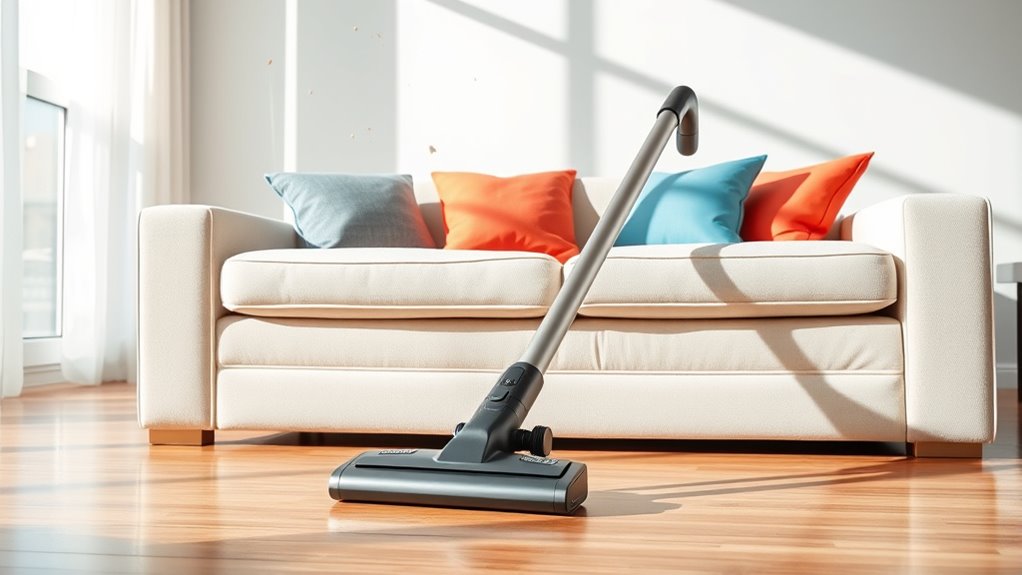
While regular vacuuming is essential for maintaining upholstery, professional cleaning every 1-2 years offers a deeper level of care that can greatly enhance your furniture’s appearance.
Here are some recommendations for professional upholstery cleaning:
- Utilize Specialized Equipment: Professionals use tools designed to clean furniture without damaging upholstery.
- Consider Stain Protection Treatments: These can help prolong the life of your fabric and prevent future stains.
- Schedule Expert Assessments: Professionals can identify any damage and recommend timely repairs tailored to your specific fabric type.
- Reduce Allergies: Regular cleaning helps eliminate allergens and dust mites, contributing to a healthier indoor environment.
Investing in professional cleaning not only revitalizes your furniture but also guarantees a cleaner, healthier living space.
Frequently Asked Questions
How Do I Make My Upholstery Look New Again?
To make your upholstery look new again, start by vacuuming it thoroughly to remove dust and dirt.
Use an upholstery attachment or soft brush to avoid damaging the fabric. Address any loose threads or snags before you clean.
For deeper restoration, consider professional cleaning every couple of years.
If spills occur, act quickly by blotting instead of scrubbing. This’ll help maintain the upholstery’s appearance and prolong its lifespan.
Should You Vacuum Upholstery?
Yes, you should vacuum upholstery regularly. It helps eliminate dust, dirt, and allergens that can accumulate over time.
By using a vacuum with an upholstery attachment, you’ll protect your furniture’s delicate fabrics while effectively cleaning them.
Make it a habit to vacuum at least once a week, especially in high-traffic areas. This not only keeps your furniture looking fresh but also prolongs its lifespan, ensuring it remains comfortable and inviting for years.
How Do I Keep My Couch Looking New?
To keep your couch looking new, vacuum it weekly with an upholstery attachment to remove dust and debris.
Address spills immediately by blotting with a damp cloth and a mild soap solution.
Rotate and fluff the cushions regularly to prevent sagging.
Protect it from direct sunlight by using curtains or positioning it away from windows.
Finally, schedule professional cleaning every couple of years to maintain its appearance and longevity.
What to Put on a Couch Before Vacuuming?
Did you know that over 80% of pet owners report finding hair on their furniture?
Before you vacuum your couch, remove any loose items like cushions and throws. Check for loose threads that could snag in the vacuum.
If your couch has removable covers, wash them according to the manufacturer’s instructions.
Finally, use a lint roller or sticky tape to pick up pet hair and debris, making your vacuuming more effective.
Conclusion
By regularly vacuuming your upholstery and furniture, you not only preserve their appearance but also extend their lifespan. While neglecting this simple task can lead to wear and tear, consistent maintenance keeps your home inviting and fresh. Embrace the balance between routine upkeep and the occasional deep clean—both are essential in achieving a pristine living space. So, grab your vacuum and take a few moments each week; the difference it makes is truly worth it.
